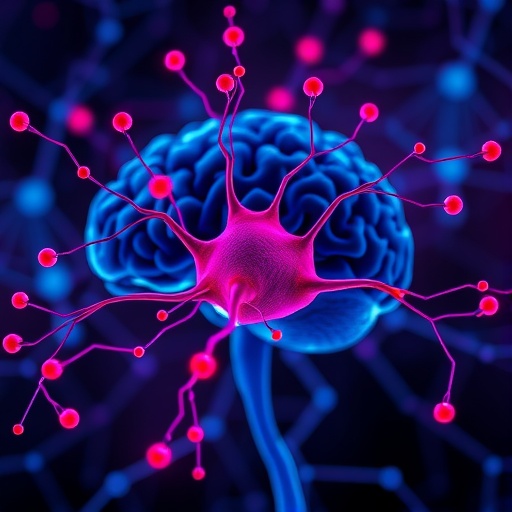In the realm of neuronal signaling, the intricacies of ion-channel function continue to captivate neuroscientists and biophysicists alike. A recent breakthrough study, published in Nature in 2025, uncovers the delicate structural mechanics behind the modulation of conductance levels in NMDA receptors (NMDARs), pivotal players in synaptic transmission and plasticity. The research delineates how subtle bending patterns of pore-forming transmembrane helices orchestrate the opening states of NMDAR channels, providing a long-sought explanation for the presence of discrete conductance states in these receptor channels.
Ion channels, fundamental to neuronal excitability, exhibit variations in conductance determined by both how often they open and the magnitude of the current through each opening—a property known as unitary conductance. The phenomenon of subconductance states, where channels partially open to produce intermediate levels of conductance, has been observed across various ion channels but lacked a comprehensive structural explanation until now. This study focuses sharply on the heterotetrameric neuronal NMDAR, specifically the GluN1a-2B subtype, revealing that the channel’s conductance spectrum is governed by the shape and bending of its transmembrane helices during gating.
Using cutting-edge single-particle electron cryomicroscopy (cryo-EM), the authors probed the conformations of NMDARs in various ligand-bound states. They discovered that the endogenous neurosteroid 24S-hydroxycholesterol (24S-HC) binds to a juxtamembrane pocket on the GluN2B subunit, a strategic position adjacent to the membrane-spanning helices. This engagement stabilizes a fully open-gate conformation, characterized by pronounced bending of both GluN1a M3 and GluN2B M3′ helices, culminating in maximal channel dilation and conductive capacity.
Contrasting this full activation scenario, the synthetic positive allosteric modulator EU1622-240 presents a unique binding profile. While it shares the GluN2B juxtamembrane pocket target with 24S-HC, EU1622-240 also occupies an additional juxtamembrane site on the GluN1a subunit. This dual-pocket binding results in a distinct ‘sub-open’ state where only the GluN2B M3′ helix undergoes bending, leading to partial pore dilation and the manifestation of stable subconductance levels. These structural nuances directly correlate with electrophysiological recordings that demonstrate predominant subconductance states under EU1622-240 modulation, as opposed to the full-conductance states enriched by 24S-HC.
The study further broadens the neurosteroid binding landscape by investigating pregnenolone sulfate, another neurosteroid class member. Remarkably, pregnenolone sulfate is shown to engage the GluN2B juxtamembrane site in a manner distinct from the others—it binds two molecules simultaneously to the same pocket, revealing an unexpected layer of complexity and versatility in neurosteroid recognition and binding dynamics. This finding suggests a potential for fine-tuned or cooperative modulation of NMDAR conductance states by endogenous and synthetic neurosteroids.
From a mechanistic perspective, the revelation that bending motions of the pore-forming M3 helices regulate ion permeation offers a fresh paradigm in ion-channel biology. The juxtamembrane pockets act as hubs where allosteric modulators—be they endogenous neurosteroids or synthetic drugs—alter the conformational flexibility of critical helices, which then translates into changes in the ion channel’s conductive properties. This structural insight elegantly explains how the channel toggles between multiple conductance states, ultimately impacting signal strength and duration.
These findings hold remarkable implications beyond fundamental neuroscience. By elucidating how neurosteroids and modulators can finely tune the gating behavior of NMDARs, the study paves the way towards novel therapeutic avenues targeting neurological disorders characterized by dysfunctional glutamatergic transmission. For example, in conditions like Alzheimer’s disease, schizophrenia, and ischemic injuries, where aberrant NMDA receptor function contributes to pathophysiology, the ability to pharmacologically steer channel conductance states could revolutionize treatment strategies.
Methodologically, the use of cryo-EM has been instrumental in dissecting these dynamic conformational states. High-resolution structures captured under varying ligand-bound conditions provide snapshots that, when combined, unravel the gating choreography. This approach surpasses traditional electrophysiological studies, allowing direct visualization of the structural correlates underpinning functional states, a leap forward in receptor biology.
Electrophysiological single-channel recordings complement the structural revelations, validating the link between helix bending and conductance levels. The congruence between structural states and electrophysiological conductance substantiates the notion that the degree of M3 helix bending is a deterministic factor for channel opening size rather than a binary open-or-closed model. The presence of intermediate subconductance openings hints at a graded gating mechanism finely modulated by distinct ligands.
Moreover, allosteric modulation via juxtamembrane pockets highlights the dynamic and modular nature of NMDAR regulation. Unlike traditional orthosteric ligands that compete with endogenous neurotransmitters, these allosteric binding sites provide an avenue for subtle and state-dependent control, which is less likely to cause desensitization or excitotoxicity. This property underscores the therapeutic potential of targeting neurosteroid binding pockets to modulate receptor function with precision.
This investigation marks a significant milestone in understanding synaptic physiology at the molecular level. It underscores that channel conductance is not simply a static property but a malleable feature derived from sophisticated structural transitions. The ability of neurosteroids to exert differential effects on channel conductance by stabilizing specific helix bend conformations adds a new dimension to the pharmacology of NMDARs.
Looking forward, this structural framework unlocks possibilities for structure-guided drug design aimed at manipulating NMDAR activity with unprecedented specificity. Pharmacological agents tailored to stabilize desired pore conformations could potentially tune neural excitability and plasticity in a nuanced manner, opening new frontiers in neurotherapeutics, from epilepsy to cognitive enhancement.
In summary, the convergent evidence from cryo-EM structures, electrophysiology, and chemical biology reveal a coherent picture: juxtamembrane pockets on NMDAR subunits serve as critical structural hubs where endogenous neurosteroids and synthetic modulators bind to sculpt pore helix bending patterns, thus fine-tuning channel conductance. These discoveries illuminate the elegant structural underpinnings of ion-channel gating and herald a new era for targeted modulation of glutamatergic signaling in the brain.
Subject of Research: Mechanisms controlling conductance levels and neurosteroid binding in NMDA receptors.
Article Title: Mechanism of conductance control and neurosteroid binding in NMDA receptors.
Article References:
Kang, H., Steigerwald, R., Ullman, E.Z. et al. Mechanism of conductance control and neurosteroid binding in NMDA receptors. Nature (2025). https://doi.org/10.1038/s41586-025-09695-4




